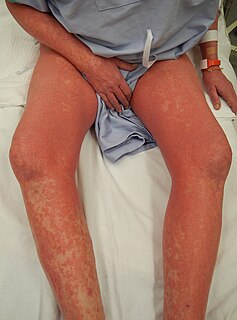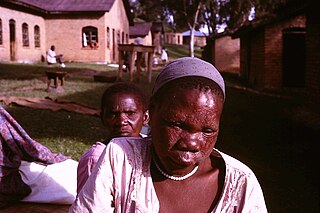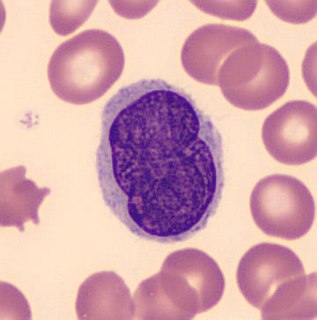Related Research Articles

Tumors of the hematopoietic and lymphoid tissues or tumours of the haematopoietic and lymphoid malignancies are tumors that affect the blood, bone marrow, lymph, and lymphatic system. As those elements are all intimately connected through both the circulatory system and the immune system, a disease affecting one will often affect the others as well, making myeloproliferation and lymphoproliferation closely related and often overlapping problems.

Anaplastic large-cell lymphoma (ALCL) is a type of non-Hodgkin lymphoma involving aberrant T cells or null lymphocytes. It is described in detail in the "Classification of Tumours of the Haematopoietic and Lymphoid Tissues" edited by experts of the World Health Organisation (WHO). The term anaplastic large-cell lymphoma (ALCL) encompasses at least four different clinical entities, all sharing the same name, which histologically share the presence of large pleomorphic cells that express CD30 and T-cell markers. Two types of ALCL present as systemic disease and are considered as aggressive lymphomas, while two types present as localized disease and may progress locally. Anaplastic large cell lymphoma is associated with various types of medical implants.

Mycosis fungoides, also known as Alibert-Bazin syndrome or granuloma fungoides, is the most common form of cutaneous T-cell lymphoma. It generally affects the skin, but may progress internally over time. Symptoms include rash, tumors, skin lesions, and itchy skin.

Cutaneous T cell lymphoma (CTCL) is a class of non-Hodgkin lymphoma, which is a type of cancer of the immune system. Unlike most non-Hodgkin lymphomas, CTCL is caused by a mutation of T cells. The cancerous T cells in the body initially migrate to the skin, causing various lesions to appear. These lesions change shape as the disease progresses, typically beginning as what appears to be a rash which can be very itchy and eventually forming plaques and tumors before spreading to other parts of the body.

Chlormethine, also known as mechlorethamine, mustine, HN2, and embikhin (эмбихин), is a nitrogen mustard sold under the brand name Mustargen. It is the prototype of alkylating agents, a group of anticancer chemotherapeutic drugs. It works by binding to DNA, crosslinking two strands and preventing cell duplication. It binds to the N7 nitrogen on the DNA base guanine. As the chemical is a blister agent, its use is strongly restricted within the Chemical Weapons Convention where it is classified as a Schedule 1 substance.

Sézary disease is a type of cutaneous lymphoma that was first described by Albert Sézary. The affected cells are T-cells that have pathological quantities of mucopolysaccharides. Sézary disease is sometimes considered a late stage of mycosis fungoides with lymphadenopathy. There are currently no known causes of Sézary disease.

T-cell lymphomas are lymphomas that affect T cells. There are four major types, and they account for about one in ten cases of non-Hodgkin lymphoma.

Leonine facies is a facies that resembles that of a lion. It is seen in multiple conditions and has been classically described for Lepromatous leprosy as well as Paget's disease of bone. It is a dermatological symptom, with characteristic facial features that are visible on presentation, and is useful for focusing on differential diagnosis.
Large plaque parapsoriasis are skin lesions that may be included in the modern scheme of cutaneous conditions described as parapsoriasis. These lesions, called plaques, may be irregularly round-shaped to oval and are 10 cm (4 in) or larger in diameter. They can be very thin plaques that are asymptomatic or mildly pruritic. Large-plaque parapsoriasis is a common associate of retiform parapsoriasis, can be accompanied by poikiloderma vasculare atrophicans, and can in rare occasions be a precursor to cutaneous T-cell lymphoma.
Drug-induced pseudolymphoma results from exposure to medications, which results in cutaneous inflammatory patterns that resemble lymphoma, most frequently mycosis fungoides.
Pagetoid reticulosis is a cutaneous condition, an uncommon lymphoproliferative disorder, sometimes considered a form of mycosis fungoides.
Granulomatous slack skin (GSS) is a rare cutaneous condition, a variant of lymphoma that typically presents in middle-aged adults.
CD30+ cutaneous T-cell lymphoma, also known as primary cutaneous anaplastic large cell lymphoma, is a cutaneous (skin) condition characterized by solitary or localized skin lesions that have a tendency to ulcerate.
Secondary cutaneous CD30+ large-cell lymphoma is a cutaneous condition that may arise in cases of mycosis fungoides, and in patients with lymphomatoid papulosis.
Lennert lymphoma is a systemic T-cell lymphoma that presents with cutaneous skin lesions roughly 10% of the time.

Lutzner cells were discovered by Marvin A. Lutzner, Lucien-Marie Pautrier, and Albert Sézary. These cells are also referred to as Pautrier’s abscess, Sézary’s cell, or Sézary-Lutzner cells. They are a form of T-lymphocytes that has been mutated This atypical form of T-lymphocytes contains T-cell receptors on the surface and is found in both the dermis and epidermis layers of the skin. Since Lutzner cells are a mutated form of T-lymphocytes, they develop in bone marrow and are transported to the thymus is order to mature. The production and maturation stages occur before the cell has developed a mutation. Lutzner cells can form cutaneous T-cell lymphoma, which is a form of skin cancer.

Poikiloderma vasculare atrophicans (PVA), sometimes referred to as parapsoriasis variegata or parapsoriasis lichenoides is a cutaneous condition characterized by hypo- or hyperpigmentation, telangiectasia and skin atrophy. Other names for the condition include prereticulotic poikiloderma and atrophic parapsoriasis. The condition was first described by pioneer American pediatrician Abraham Jacobi in 1906. PVA causes areas of affected skin to appear speckled red and inflamed, yellowish and/or brown, gray or grayish-black, with scaling and a thinness that may be described as "cigarette paper". On the surface of the skin, these areas may range in size from small patches, to plaques, to neoplasms.
Mogamulizumab is a humanized, afucosylated monoclonal antibody targeting CC chemokine receptor 4 (CCR4). The US FDA approved it in August 2018 for treatment of relapsed or refractory mycosis fungoides and Sézary disease. It was approved in Japan in 2012 for the treatment of relapsed or refractory CCR4+ adult T-cell leukemia/lymphoma (ATCLL) and in 2014 for relapsed or refractory CCR4+ cutaneous T cell lymphoma (CTCL). The latter approval was based on study with 28 subjects.
References
- ↑ James, William D.; Berger, Timothy G.; et al. (2006). Andrews' Diseases of the Skin: clinical Dermatology. Saunders Elsevier. ISBN 978-0-7216-2921-6.
| This cutaneous condition article is a stub. You can help Wikipedia by expanding it. |